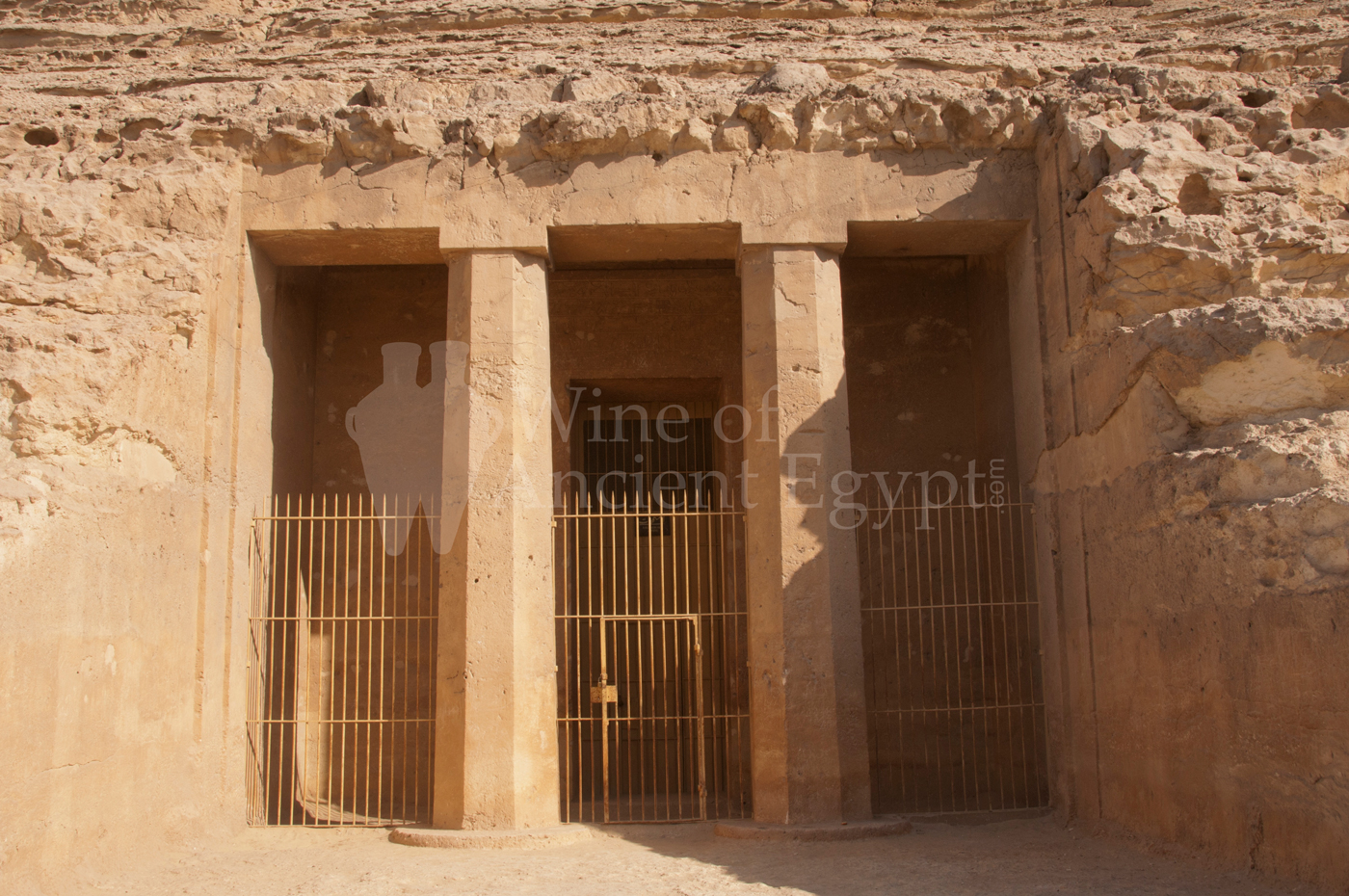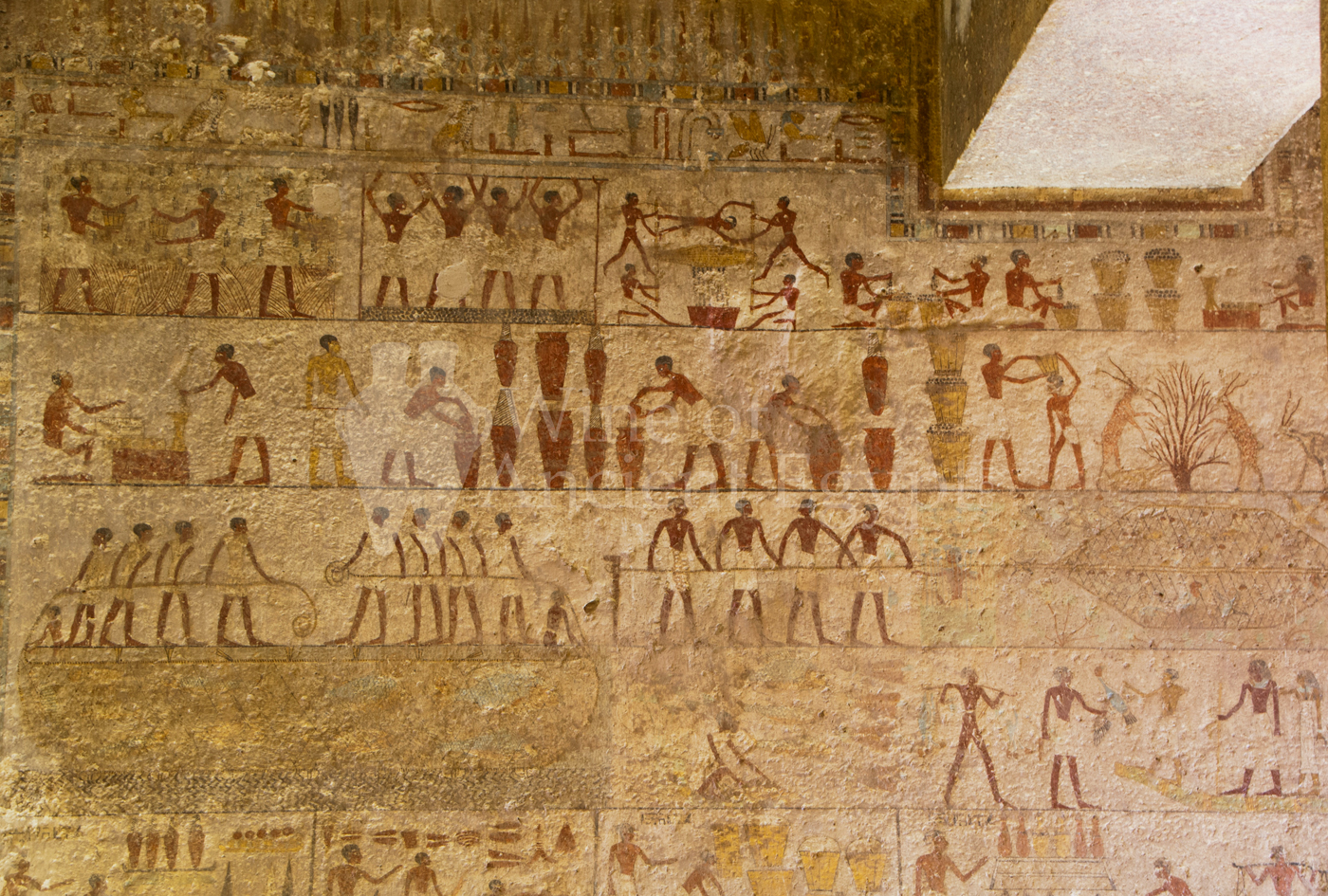[DATABASE SCENES RECORD 37] - Close record
A very complete and well-preserved scene of viticulture and winemaking in two registers. In the upper register, trellised vineyards not visible, only long herbs and detailed grape bunches are shown. Three workers pick up the grapes and put them in small baskets that they hold with one hand. To the right are four men treading the grapes in a low vat, where grapes are visible from the front, with their feet, while their hands are hanged from an upper pole of the winepress. Further to the right are five men pressing the remains of the grapes in a sack-press; the sack is twisted by means of poles put through the looped ends and the juice falls to a vat; four men twist the poles, while a fifth places himself horizontally between them to push them apart and keep the bag at a full stretch. To the right of the last scene are three seated men counting the bunches of grapes which are in the baskets in front of them, another four big baskets full of grapes are there already counted, and a seated scribe is recording the number of grape bunches counted. Below the upper register: two men, one seated on the left and another man standing on the right, count the wine jars. To the right of them is a supervisor controlling two workmen while filling jars with must for fermentation. Between them there are six jars: the two in the middle are big jars opened and a wide mouth containing must for fermentation and the other four jars are already sealed. To the right is a man filtering the must?, adding dried grapes? or sealing? a wine jar. There are another two wine jars beside him: the one on top is sealed and the one below is not sealed. To the right are three big baskets full of grapes, another small one is carried by a man on his head, while another man is helping him. Finally, four goats are browsing and cleaning a tree or vine: one sits eating and two standing goats eat the tendrils of the vine, while the fourth goat arrives from the right side. They eat the rests of the leaves at the end of the season, which is a way to prepare the vine for the winter (and this procedure has been recently introduced in modern vineyards).
TOMB INFORMATION
Type: Rock-cut tomb
Tomb Owner: Amenemhat (Ameni) - Amenemhet
Titles: Prince - Ha-prince - Sahu (treasurer?) of the King of Lower Egypt - Confidential friend of the King - Royal acquaintance, True royal acquaintance and True royal acquaintance of the South - Great chief of the Oryx-nome - Regulator of the two thrones - Great of gifts (?) in the house of the King - Superintendent of the two (?) pools of sport - Overseer of horns, hoofs, feathers and minerals - Superintendent of all things which heaven gives (and) earth produces - He who is in the chamber - He who belongs to the city of Nechen - Chief of the city of Necheb - Chief captain of the host of the Oryx-nome - Superintendent of the priests of Chem, Lord of Herur - Priest of Shu and Tefnut - Priest of Horus of the two scorpions - Priest of Anubis Within the house of Shemsu - Consort in the house of the goddess Net - Superintendent of the temples - Set over the mysteries of divine words - Regulator of the sa (rank or succession) in the temples - Superintendent of the distribution (?) of the divine offerings - A noble great of years in the house of the god Am...t - Chief lector - Sem-master of all the tunics - Regulator of the temples of Net (?)
REFERENCES
1- Newberry, P. E., 1893, Beni Hassan, part I, ASE, London, pp. 31, Pl. xii.
2- Porter, B. & Moss, R. L. B., 1968, Topographical Bibliography of Ancient Egyptian Hieroglyphic Texts, Reliefs, and Paintings. IV. Lower and Middle Egypt, Oxford, p.143.
3- Montet, P., 1911, Notes sur les tombeaux de Beni Hassan, BIFAO 9, p. 2.
4- Tallet, P., 1998, Le vin en Egypte ancienne à l'époque pharaonique, Unpublished Thesis, Paris, p. 375-376.
5- Shedid, A.G., 1994, Die Felsbräber von Beni Hassan in Mittelägypten, Zaberns Bildbände zur Archäologie, Band 16, Antike Welt, Mainz am Rhein, p. 46 (Abb 77).
6- Rosellini, I., 1834, I Monumenti dell'Egitto e della Nubia II, Monumenti Civili, Pise, pl. 37 (no.1).
7- Kanawati, N. & Woods, A., 2010, Beni Hassan. Art and daily life in an Egyptian province, SCA, Cairo, pp. 24, pp. 31, fig. 24, pp. 32, fig. 25.
8- Baines, A. V. 1995, Iconography as biography. A study of the Middle Kingdom Egyptian tombs at Beni Hassan, El-Bersha and Meir (c. 2040-1840 B.C.), University of Stellenbosch, Dissertation PhD, pp. 249-250, fig. 203.


